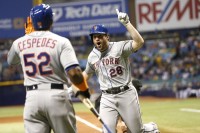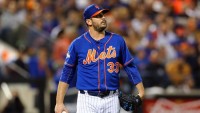Juan Lagares

What a difference a year makes. This time last year, Juan Lagares was coming off a 5.5 WAR season and a Gold Glove. There was discussion about him being the leadoff hitter in 2015. He seemed to be ready to take the next big step in his career.
Instead, Lagares regressed in every aspect of his game. His epic defense noticeably slipped. His batting average, on base percentage, and slugging percentage dropped. Eventually, he forced the Mets to trade for an outfielder at the trade deadline. A player that was supposed to have a breakout year became a platoon player and a late inning defensive replacement.
The Mets tried to trade Lagares at the deadline. The initial plan was to sign Alejandro De Aza to play a platoon with Lagares. When it became apparent the Mets could sign Yoenis Cespedes on a short term deal, they moved to get that done. That makes Lagares a fourth outfielder, at best, and a defensive replacement in 2016. Apparently, he has an untradeable contract.
That begs the question of what will be Lagares’ future with the Mets?
As noted in 2016, it will be as a bench player and late defensive replacement. Beyond that is anyone’s guess. Will he be able to build off a strong postseason? Will his elbow heal sufficiently enough to permit him to throw better in the outfield and/or swing the bat better? The Mets hope the answer to all these questions is yes.
Cespedes has an opt out after this year, and he could be out the door after this season. Curtis Granderson is only signed through 2017. Furthermore, he’s going to be 35 by Opening Day. Who knows if Brandon Nimmo will ever become a major leaguer let alone a starting outfielder? Also, as noted, Lagares may have an untradeable contract. He’s due to make $4.5 million in 2017, $6.5 million in 2018, and $9.0 million in 2019.
Personally, I’m still high on Lagares. He showed a lot in the postseason. He should be able to become the best defensive center fielder in baseball again. He’s got another year to work with Kevin Long to see if he can help Lagares maximize his offensive abilities.
Lagares is going to get his chances this year. He should play in almost every game to provide late inning defensive help. He should get starts against lefties allowing Granderson or Michael Conforto a day off. So yes, Lagares will be a bench player in 2016, but he will also have plenty of opportunities to improve. He will have plenty of opportunities to show the Mets he’s an important part of the Mets’ future.
Hopefully, this year, Lagares will take that step forward we were all hoping he would take last year.

After the Mets make a decision at catcher, the team appears like they will have between $82 – $96 million to build a roster and re-sign their pitching.
Looking at the roster, the Mets will need to obtain starters at the following positions: 1B, 2B, SS, and RF. David Wright is scheduled to make $15 million, so whether or not you believe he will be able to stay at the position, he will remain with the team in some capacity. Michael Conforto should still be with the team as the leftfielder. Finally, unless the Mets can move him, Juan Lagares and his $9 million salary will be the team’s centerfielder. The Mets organization is fairly well stocked with position players right now, and they might be able to fill out the roster with cheap, cost-controlled talent.
First Base
Somewhat controversely, Keith Law named Dominic Smith the 29th best prospect in all of baseball. He’s the first baseman of the future.
Accordingly to the scouting reports, Smith is a good defensive first baseman that should be able to hit. The debate really is whether he will hit for power. Whether or not he hits for power, people see him as being able to field the position and be a good major league hitter.
With Lucas Duda being a free agent in 2018, the Mets will need Smith to be ready. If he’s not ready, the Mets will need a stopgap. In either event, by the time the Mets pitchers start to become free agents, Smith should be the first baseman earning around $500,000.
Second Base
We have to assume that one of these years Dilson Herrera is going to transition from second baseman of the future to the Mets second baseman. With Neil Walker only having one year until free agency, it appears that time will be 2017.
Right now, Herrera has less than one year’s service time. For all the supposed newfound depth, it’ll probably be Matt Reynolds getting called up to the Mets. That will preserve his service time. It means that in 2019, Herrera should be the second baseman, and he will have accrued two full years service time. Unless he gets enough playing time, it appears like he will avoid Super Two status meaning he will be in the same $500 – $600 thousand range as Smith.
Shortstop
As far as organizational depth, the Mets seemingly have an embarassment of riches with two high end shortstop prospects with Gavin Cecchini and Amed Rosario. They also have the aforementioned Reynolds.
Given Asdrubal Cabrera‘s contract, Cecchini and Rosario are going to have time to develop on the minors. At a minimum, Cabrera is signed to be the Mets shortstop through the 2017 season. If he produces well, or the prospects need another year, Cabrera has an option that could keep him with the Mets through the 2018 season.
As such, neither Cecchini or Rosario will be arbitration eligible at the time the Mets pitchers start to reach free agency. Accordingly, the Mets will only have to spend around $500 thousand when the pitchers begin to become free agents.
Left Field
It seems Michael Conforto is the leftfielder of the past (2015), present, and future. He very well should be too. Even if Conforto doesn’t improve upon his 162 game averages he achieved as a 22 year old, who never played above AA, you’re getting a good defensive outfielder who will hit .270/.335/.506 with 26 homers and 75 RBI.
Fortunately, Conforto will not have accrued enough service time to achieve Super Two status. Unfortunately, Conforto will most likely become arbitration eligible the same time that the Mets pitchers are reaching free agency.
Looking over the past few years, there isn’t really a good comparable to Conforto. It seems that when teams have good young corner outfielders, they lock them up. With that in mind, although an admittedly imperfect comparison, J.D. Martinez is instructive.
In 2014, Martinez was 26 years old, and he hit .325/.358/.553 with 23 homers and 76 RBI in 123 games. He became arbitration eligible after this season, and he agreed to $3 million. In 2015, he had another good year hitting .282/.344/.535 with 38 homeruns and 102 RBI. He and the Tigers avoided an arbitration hearing. Martinez’s contract extension bought out the remainder of his arbitration years he’s due to make $6.75 million in 2016 and $11.75 million in 2017.
While we may or may not agree on whether Martinez is a good comparable, it would be fair to say Conforto is at least capable of hitting .272/.344/.535 by his age 25 season, if not sooner. If that’s the case, it would be fair to suggest Conforto could earn anywhere from $3 – $6 million in his first year of eligibility.
Right Field
Curtis Granderson‘s contract will expire after the 2017 season. Since he will be 37 heading into the 2018 season, it’s hard to imagine he will be re-signed to be the everyday right fielder.
Now, Wuilmer Becerra projects to be an everyday player. Scouts believe he has the bat to play the corner outfield spot. The issue as far as the Mets are concerned is how quickly the 21 year old minor leaguer will need before fulfilling that promise. Last year, Becerra played his first year in full season A ball. That’s a long trek to the majors by 2019.
So unless Brandon Nimmo can handle the corner outfield offensively, which unfortunately seems unlikely, the Mets will have to look outside the organization to fill that void.
If Becerra is still a well regarded prospect, the Mets are likely to bring in a player on a one to two year deal. In retrospect, depending on how he finishes out his contract, Granderson could be coaxed back on a one-year deal ata much lower contract price.
As a placeholder, let’s presume the cost of a right fielder would cost about $15 million. That’s what Granderson is slated to earn the last year of his contract.
Cost of the Projected 2019 Starting Lineup
If everything breaks right for the Mets, they will have a group of young, cost-controlled position players at the time their starting pitchers hit the free agent market. If this pans out, the Mets everyday position players would cost about $46.5 million.
That’s roughly what the Mets are paying their current starting infield. In total, the 2016 Mets starting lineup is due to be paid roughly $90 million. Essentially, the Mets will be spending half the amount of money on their starting lineup in 2019 than they will this season.
Overall, this leaves the Mets between $35.5 – $49.5 million to build a bench, a bullpen, and to pay their starting rotation if the payroll remains stagnant at the $140 million range.

At the press conference today re-introducing Yoenis Cespedes, the issue of what Alejandro De Aza‘s role will be. Naturally, he’s expected to be on the bench ready, willing, and able to play all three outfield positions. Perhaps, that is jumping the gun a bit:
https://twitter.com/jareddiamond/status/694964819003359232
This really just confirms what every Mets fan thought when De Aza came aboard. De Aza signed with the Mets to share centerfield duties with Juan Lagares. The move was made because the Mets never thought they were going to be able to sign Cespedes. Yet, somehow, Cespedes returned to the Mets leaving behind Lagares and De Aza platooning on the bench.
Now, we are not privy to what, if any, promises were made to De Aza. We do know at the time De Aza was signed, the Mets were fairly steadfast they were not re-signing Cespedes. With that said, it’s fair to say, De Aza came to the Mets to be at worst their fourth outfielder. At a minimum, it appeared he was going to have a legitimate shot to get the bulk of the at bats in centerfield. Now, he’s the team’s fifth outfielder. I’m sure he’s not happy with being pushed down the depth chart without even playing one game, especially when he could’ve signed anywhere.
Now, De Aza can’t be traded until June 15th unless he consents to a deal, which he very well might. While every player wants to win, every player also wants to play. Right now, De Aza’s at bats will be few and far between as he’s the left-handed option off the bench, and the corner outfielders hit left-handed as well. He could be buried on the bench for a while. It’s not exactly an exciting proposition for a 31 year old utility outfielder.
So yes, we understand why De Aza would want to be traded, but why would the Mets want to trade him? With the Brandon Nimmo injury and the Darrell Ceciliani trade, De Aza is it when it comes to organizational centerfield depth. Well, there are a few good reasons.
First, De Aza may not be happy on the bench for long stretches, especially after he thought he could be a starter with the Mets. Having a disgruntled player is never good for your clubhouse. While Terry Collins was quite adept at handling the clubhouse last year, it doesn’t mean you should introduce a potential problem from the start. No, I’m not suggesting De Aza is a bad guy. Rather, I’m saying any player not getting sufficient playing time is an issue that will eventually come to a head.
Another reason you trade De Aza now is this might be the time when he has his most value. As teams look to fill out their rosters as Spring Training and/or the regular season approaches, De Aza may become a more attractive option. The Mets aren’t likely to get much in return, but whatever they do get is most likely to be better than what they get around the trade deadline.
Whether or not the Mets trade De Aza, we should be able to agree on one thing. De Aza is here because the Mets never expected Cespedes to be here. Now the Mets need to find playing time for FIVE major league caliber outfielders. This really is a nice problem to have after the problems we saw with the Mets last year.
Sometimes, it’s great when the plan doesn’t come together.
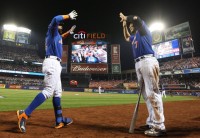
It’s incredible to think Yoenis Cespedes is back with the Mets. Everyone associated with the Mets should be thrilled. Cespedes’ presence on the Mets makes them a better team than the one they had. The question is how much better.
Well, first let’s get some things out of the way. Cespedes will not be as good as he was when he first came to the Mets. He was insanely hot. He hit 17 homers in a less than two months. That’s roughly a 50 homerun pace. He has power, but he’s never shown that much power. Cespedes also isn’t the .150 hitter we saw struggle in the World Series. As with everything else in life, the truth is somewhere inbetween.
Cespedes is a career .271/.319/.486 hitter. In an average season, he hits 30 homers and 103 RBI. His OPS+ is 122. His wRC+ is 121. All of this is to say that while he’s not the hitter he was initially with the Mets, he’s still a very effective slugger. The various projections seem to think he’ll hit a little worse than his career averages next year:
- Marcel: .265/.309/.480 with 26 homers and 88 RBI
- Steamer: .266/.312/.463 with 26 homers and 72 RBI
- ZiPS: .270/.312/.498 with 30 homers and 98 RBI
So, the projection systems, for what they’re worth, see Cespedes’ production dipping slightly in 2016. Part of that could be his first post-30 year old season. Part could be his .236/.302/.491 batting line Cespedes has had at Citi Field. I believe all Mets fans believe the reason should be that these projections are plain wrong and Cespedes will be more like he was in August and September.
The thing is Cespedes is going to have to be that 30+ homerun guy for the Mets. He needs to be that guy not only because the lineup needs another power threat, but also the fact that he needs to makeup for the fact that he’s a poor centerfielder. Remember, he has a career -12.6 UZR and -17 DRS in centerfield. Those are ugly numbers. Numbers which should be somewhat abated by Juan Lagares coming in late as a defensive replacement thereby shifting Cespedes to his natural LF.
So overall, it seems Cespedes will be poor defensively, and he will hit for power. More importantly, with Cespedes the Mets should be projected to win the NL East. Once the Mets get to that point, they have the pitching to win the World Series.
I’m projecting a very fun 2016 ahead.
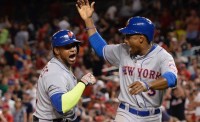
Right now, there are two people who are realistically standing in the way of Yoenis Cespedes returning to the Mets. No, it’s not Fred and Jeff Wilpon. It’s Michael Conforto and Curtis Granderson.
Like it or not, Sandy Alderson was right when he said Cespedes isn’t a centerfielder. While Cespedes grades out as an elite leftfielder, he’s just not good in center. Last year, he had a -3.2 UZR and -4 DRS while playing center. For his career, his UZR in center is -12.6, and his DRS there is -17. While the Mets were willing to move him in and out of center to take advantage of platoon splits for Juan Lagares while not forcing Conforto to face lefties. While it was rough at times, it did seem to work.
However, that was over the course of three months. Cespedes’ defensive numbers in center are unsustainable over a full season. I don’t buy the argument he only needs to play there two years. He’s already established he shouldn’t be playing there now. No, if the Mets want to re-sign him, he needs to go either left or right. That begs the question, why haven’t the Mets made room for him?
Specifically, I’m asking why the Mets haven’t explored trading Granderson. Last year, Granderson hit .259/.364/.457 with 26 homers and 70 RBI from the leadoff spot. He was a finalist for the Gold Glove in rightfield. On a team where everyone was dropping like flies, he played 157 games, and really, he was the only credible major league bat in the lineup for far too long stretches of time. His 5.1 WAR ranked him as a top five rightfielder in all of baseball last year. He has a reasonable two years $31 million remaining on his contract. One way of looking at this is saying he’s too valuable to be traded.
Another is to say he’s at his peak value, which is the precise time you want to trade players. Granderson is a year removed from a .237/.326/.338 campaign. The year before that he hit .229/.317/.407. He had pronounced splits last year hitting .183/.273/.286 against lefties and .280/.388/.504 against righties. His 5.1 WAR last year was the highest it had been since 2011. He’s going to be 35 on Opening Day next year.
Right now, the Mets still project to have Eric Campbell make the Opening Day roster until they sign another 1B/OF. The Mets still talk about adding another reliever. Their farm system took a big hit last year. Couldn’t trading Granderson address one, two, or all three of these needs? Isn’t that what smart front offices do? Don’t they trade away a player a year too early rather than a year too late?
Also keep in mind,this is a heavy left-hand hitting team. Trading Granderson and re-signing Cespedes would balance that out a bit. Isn’t this something worth exploring?
Personally, I’d like to see the Mets keep Granderson. I’m a big fan of his on and off the field. With that said, trading Granderson now may be the right thing to do. His value won’t be any higher, and the Mets have some needs to address. The Mets do not want to be paying for Granderson during his possible decline.
It might be time to trade Granderson.
Editor’s Note: this article first appeared on metsmerizedonline.com
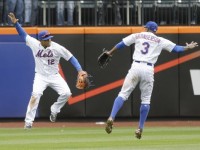
Fans are clamoring for Yoenis Cespedes. They want him. They need him. Here’s the problem. What’s the corresponding move?
When the Cubs signed Ben Zobrist, they were prepared. They had a deal worked out for Starlin Castro to go to the Yankees. Having the deal in place helped prevent the market from suppressing Castro’s value because the Cubs would’ve had to trade Castro. If the Mets want to sign Cespedes, they’re going to have to do the same thing.
Right now, the Mets have Michael Conforto in left, Juan Lagares and Alejandro De Aza platooning in center, and Curtis Granderson in right. If you sign Cespedes, something’s gotta give. Let’s start with the obvious. You’re not moving Conforto. Also, with the Mets signing De Aza cannot be traded until June 15th. That leaves Granderson and Lagares. Which one do you move? It’s a matter of selling low on Lagares or selling high on Granderson.
If you trade Lagares, you’re trading an elite defensive player. He was a 5.5 WAR player and a Gold Glover just in 2014. He had a down year in 2015. We don’t know how much of it had to do with his elbow injury, but he fell off the map defensively. He went from an 18.6 UZR to a 3.5. Basically, he went from a Gold Glover to merely above average. If Lagares isn’t elite defensively, he’s not an everyday player.
I still think Lagares has value. He had a terrific postseason hitting .348/.375/.435. He performed well in Winter League action this, even if he showed platoon splits. He’s still just 26 years old. The hope is he rebuilds his value. If he does, and you sell low, you’re going to regret it.
The other choice is Granderson, who may be at the apex of his value. Last year he hit .259/.364/.457. He was a dynamic leadoff hitter. For long stretches of the season, he was the only legitimate hitter in the lineup holding things together. He was a Gold Glove finalist. He was the best position player on the Mets last year. He then followed it up with a great postseason. He hit three World Series homeruns. He’s a great fit for a win-now team like the Mets.
However, he is turning 35 before the start of the next season. He’s a year removed from a .237/.326/.388 season. He just had surgery on a torn ligament in his thumb. There are risks relying upon his production for next year.
The last option would be to keep everyone. That is a monumental task for Terry Collins. You have to keep Lagares and De Aza happy with even more limited at bats. You have to hold off on the temptation of benching Conforto for stretches if he struggles or goes into a prolonged slump. There’s an issue of relying on Wilmer Flores too much. Remember, he hit .263/.295/.408 last year. The Mets still need a 1B/OF option.
Putting aside the issues it would create, Cespedes is a good player who could help the Mets. The fans want him. The issue then becomes who do the fans want to jettison?

From what I gather from reading incorrect interpretations of the book, I take many people did not actually read Moneyball. If you haven’t, you should go and read it. If you have, now is the time to re-read it.
The reason to re-read it now is the script for the Mets postseason lies within those pages. I know Sandy Alderson was no longer the A’s GM at the time; it was Billy Beane. However, remember Beane’s top two lieutenants were J.P. Riccardi and Paul DePodesta. Until recently, they were Alderson’s top lieutenants. They were at least in place when the Mets were creating their offseason plans.
One of the many aspects of the book, which the movie seemed to get purposefully wrong, was how the A’s went about replacing Jason Giambi and one-year rental Johnny Damon. In essence, the A’s determined they flat out didn’t have enough money to replace these guys with other high priced players. Instead, the A’s were going to have to replace their production using a different line of thinking. I’m summing up here and being a little over simplistic, but here was the thought process:
- The team needed to identify what was undervalued on the free agent market (OBP);
- They needed the cumulation of their entire roster to replace Giambi and Damon since they couldn’t just sign two big name free agents to do it; and
- They needed to do it as cheaply as possible.
So what did they do? Well we know the Scott Hatteberg story with him being moved to first due to his traditionally high OBP (more on that later). In the movie and most other places, the story behind the David Justice acquisition is plain wrong. The A’s obtained him from the Mets, not the Yankees, in exchange for a LOOGY by the name of Mark Guthrie and a mistake waiting to happen by the name of Tyler Yates. It was the Mets, not the Yankees, who kicked in salary. It was only $1.2 million.
Now for the moves that haven’t received much fanfare. The A’s handed the secondbase job to a young Mark Ellis, who was capable of higher production than last year’s second baseman Frank Menechino. Menechino was moved to the bench to create a deeper roster. The A’s traded for Carlos Pena, who was a promising young player. Pena was supposed to be the first baseman with Hatteberg at DH and Justice in LF. That’s the way it was up until the trade deadline. They also traded for Billy Koch to sure up the closer’s role for the departed Jason Isringhausen.
By design, the A’s replaced Giambi and Damon not only with Pena and Justice, but by also improving their DH spot (Olmedo Saenz and Jeremy Giambi) and secondbase. In essence, the A’s added three new starters putting their old starters on the bench. The A’s left some payroll flexibility and had assets for the trade deadline.
The A’s used Pena in a three way trade to acquire Ted Lilly to sure up the rotation behind their three young big pitchers. They then used a prospect to acquire Ray Durham to DH with some needed cash. Hatteberg moved to be the full time first baseman. And yes, like in the movie, the A’s also added Ricardo Rincon to be the LOOGY to sure up the bullpen.
Did it work? If you look at the record, it absolutely did. They went from a 102 win team to a 103 win team. However, the reason wasn’t Hatteberg or Rincon. No, the part we forget is Barry Zito won the Cy Young, and Miguel Tejada win the MVP. They were powered by an insane 20 game winning streak. Lost in that streak was the A’s played only one team over .500 and played two teams that lost over 100 games that year.
The 2002 A’s got top notch performances from their top guys, and they made sure to beat the teams they were supposed to beat. Make no mistake. The 2002 A’s were worse. They scored 84 less runs and allowed nine more runs. However, at the end of the day, it didn’t matter. They won one more game.
The Mets are in a similar position as the A’s were. Make no mistake about it, the Mets have limited funds. With those funds, they needed to go out and replace the production of Daniel Murphy and a half a season of Yoenis Cespedes. Last year, Murphy hit .281/.322/.449 with 14 homers and 73 RBI. Cespedes hit .287/.337/.604 with 17 homers and 44 RBI in his time with the Mets.
We already know how the Mets replaced that production. They traded for Neil Walker, who hit .269/.328/.427 with 16 homers and 71 RBI. He’s a career .272/.338/.431 hitter. The Mets then decided to go with a platoon in center. There is in-house option Juan Lagares to hit against lefties. He hit .273/.333/.438 against lefties last year and .279/.325/.427 for his career. Platooning with him is Alejandro De Aza, who hit .278/.351/.448 against righties last year and .274/.338/.418 for his career. Now, this isn’t enough to replace the production of both of Murphy and Cespedes.
That’s where Asdrubal Cabrera comes in. Last year, Wilmer Flores played the bulk of time at shortstop hitting .263/.295/.408. Ruben Tejada played a lot there hitting .261/.338/.350. The Mets hoped by signing Cabrera they have significantly upgraded the position to cover the loss of Murphy and Cespedes. Cabrera hit .265/.315/.430 last year with the Rays. Speaking of replacing Cespedes’ second half production Cabrera hit .328/.372/.544 in the second half last year. Tangentially, the bench is theoretically better by having Flores and Tejada there.
Following the script they invented in Oakland, the Mets have already done what they believe they needed to do to replace the production they have lost. Right now, the Mets projected payroll is ~$106 million or about $4 million less than the 2015 payroll. Accordingly, the Mets are maintaining payroll flexibility like the A’s did so they can make trades at the deadline.
And, by the way, the Mets are powered by their three big young starters. How will it work out in 2016? We don’t know yet. However, if history is any lesson, the 2016 Mets will be worse than the 2015 version. If they want to have a better record, the 2016 Mets will need to take advantage of their games against bad teams like the Phillies and Braves. One of the young pitchers will have to step up even more. We’ll see which everyday player can step up to have the Tejada-like season.
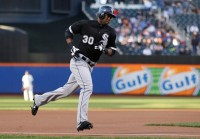
Apparently, the Mets are in no rush to acquire a centerfielder who can hit right-handed pitching:
The #Mets have Denard Span, Will Venable and Alejandro De Aza on their radar as left-handed CF options. They're slow-playing it.
— Jerry Crasnick (@jcrasnick) December 21, 2015
The name there that is new is Alejandro De Aza. He will turn 32 next year, and he’s a left-handed outfielder. In his career, he has hit .274/.338/.418 against righties. He hit .278/.351/.448 against them last year while playing 90 games for three different teams. So he fits as a platoon partner for Juan Lagares offensively. The question is how does he fit defensively?
He’s not bad actually. Not great, but not bad. For some reason, he only played CF eight innings last year, but his career UZR there is 1.8, meaning he can handle the position. Typically, he averages a 0.2 per season.
Does he have the potential upside of a Denard Span? No, but he also doesn’t have the same downside. Span has just had labrum surgery on his hip on top of two other surgeries. Span has been as defensively two years running. While he and De Aza are the same age, Span has a lot more tread on those tires.
De Aza is also a definitive upgrade over Kirk Nieuwenhuis. While they are similar defensively, De Aza hits righties much better. Nieuwenhuis hit righties .210/.277/.403 last year and .245/.314/.423 for his career.
Overall, De Aza is the perfect fit for the Mets. He hits righties. He can play a respectable centerfield. He’s also going to be cheap. De Aza made $5 million last year. There’s no reason to expect he’ll make much more than that. It’s also possible he signs for less. With the Mets current financial situation, De Aza should be the direction they go.
You know what you’re getting from him. He’s going to provide exactly what you need. If Lagares rebounds, you can justify sitting De Aza for him. Also, did I mention he’s going to come cheap? If you’re getting Span on a one-year heavy incentive laden deal, I understand going that direction. However, his agent may have something to say about that.
With all that said, I’ll take De Aza.
